What is Price Elasticity of Demand?
Price elasticity of demand is the measure of a change in the quantity demanded of a product due to change in the price of the product in the market.
Table of Content
- 1 What is Price Elasticity of Demand?
- 2 Price Elasticity of Demand Formula
- 3 Price Elasticity of Demand Example
- 4 Types of Price Elasticity of Demand
- 5 Measurement of Price Elasticity of Demand
- 6 Factors Affecting Price Elasticity of Demand
- 7 Importance of Price Elasticity of Demand
- 8 Business Economics Tutorial
In other words, Price elasticity of demand can be defined as the ratio of the percentage change in quantity demanded to the percentage change in price.
Also Read: Types of Price Elasticity of Demand
Price Elasticity of Demand Formula
Price Elasticity of Demand Formula can be mathematically expressed as:
A percentage change in demand and price is denoted with a symbol Δ.
Thus, the formula for calculating the price elasticity of demand is as follows:

Where,
ep = Price elasticity of demand
P = Initial price
ΔP = Change in price
Q = Initial quantity demanded
ΔQ = Change in quantity demanded
Price Elasticity of Demand Example
Let us understand the concept of price elasticity of demand with the help of an example.
Price Elasticity of Demand Example: Assume that a business firm sells a product at the price of 450. The firm has decided to reduce the price of the product to 350. Consequently, the demand for the product is raised from 25,000 units to 35,000 units. In this case, the price elasticity of demand is calculated as follows:
Here,
P = 450 DP = 100 (a fall in price; 450 – 350 = 100)
Q = 25,000 units
ΔQ = 10,000 (35,000 – 25,000)
By substituting these values in the above formula, ep = 1.8
Thus, the elasticity of demand is greater than 1.
Also Read: Income Elasticity of Demand
Types of Price Elasticity of Demand
There are 5 types of price elasticity of demand as mentioned below:
- Perfectly Elastic Demand
- Perfectly Inelastic demand
- Relatively Elastic Demand
- Relatively Inelastic Demand
- Unitary Elastic Demand
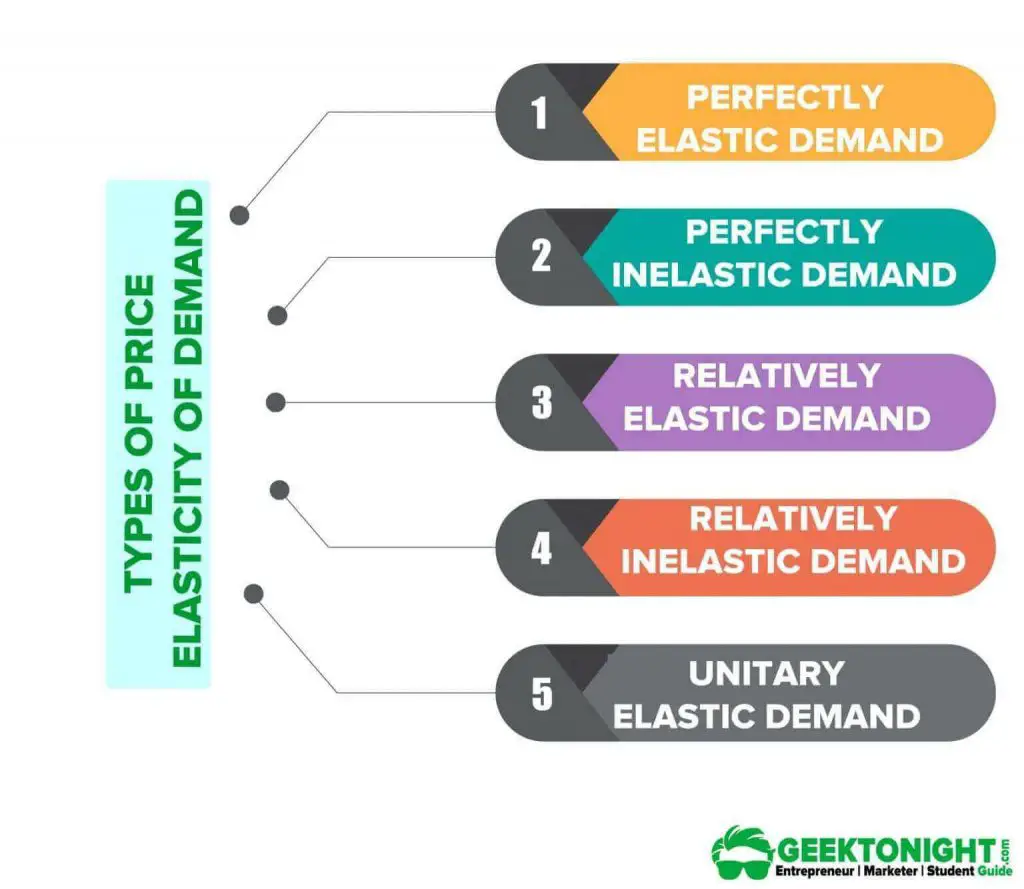
Perfectly Elastic Demand
When a small change (rise or fall) in the price results in a large change (fall or rise) in the quantity demanded, it is known as perfectly elastic demand.
Perfectly Inelastic Demand
When a change (rise or fall) in the price of a product does not bring any change (fall or rise) in the quantity demanded, the demand is called perfectly inelastic demand.
Relatively Elastic Demand
When a proportionate or percentage change (fall or rise) in price results in greater than the proportionate or percentage change (rise or fall) in quantity demanded, the demand is said to be relatively elastic demand.
Relatively Inelastic Demand
When a percentage or proportionate change (fall or rise) in price results in less than the percentage or proportionate change (rise or fall) in demand, the demand is said to be relatively inelastic demand.
Unitary Elastic Demand
Unitary elastic demand occurs when a change (rise or fall) in price results in equivalent change (fall or rise) in demand.
Also Read: Cross Elasticity of Demand
Measurement of Price Elasticity of Demand
An organisation needs to estimate the numerical value of change in demand with respect to change in the given price for making various business decisions. The numerical value of elasticity of demand can only be estimated by its measurement.
Organisations use various methods for measuring price elasticity of demand.
Commonly used methods of measuring price elasticity of demand:
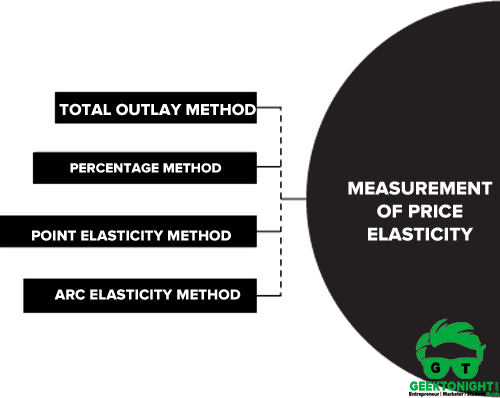
Let us discuss study these methods in detail.
Total Outlay Method
Definition Total outlay method: Price elasticity of a product is measured on the basis of the total amount of money spent (total expenditure) by consumers on the consumption of that product.
Using this method, price elasticity is determined by comparing consumers’ expenditure or outlay before the change in the price with that of after change in the price. By comparing so, the.
In the total outlay method, three cases are considered, which are:
- If the total outlay remains unchanged after there is a change in the price of the good, the price elasticity equals one (ep = 1).
- When a fall in the price of the good results in a small increase in the quantity demanded leading to a decline in total outlay, the elasticity of demand is less than one (ep < 1).
- When a fall in the price of the good brings a large increase in the quantity demanded resulting in the rise of total expenditure, elasticity of demand is greater than one (ep >1).
Total outlay method Example
The quantity demanded for notebooks at the original price and changed price are given as follows:
| Price | 15 | 9 | 15 | 9 | 15 | 9 |
| Quantity Demanded | 30 | 50 | 20 | 25 | 40 | 70 |
Calculate the price elasticity using the total outlay method.
Solution: Table shows the calculation of price elasticity of demand
using the total outlay method:
| Original Price | New Price | Original Quantity | New Quantity | Original | New | Price Elasticity of Demand |
| 15 | 9 | 30 | 50 | 450 | 450 | Here, outlay is equal in both cases; therefore, ep = 1 |
| 15 | 9 | 20 | 25 | 300 | 225 | Here, a change in outlay is less than the original outlay; therefore, ep < 1 |
| 15 | 9 | 40 | 70 | 600 | 630 | Here, a change in outlay is greater than the original outlay; therefore, ep > 1 |
Percentage method
Percentage method is also known as the ratio method. Using this method, a ratio of proportionate change in quantity demanded to the price of the product is calculated to determine the price elasticity.
ep = Q2 – Q1 / Q1 ÷ P2 – P1/ P1
Where,
Q1 = Original quantity demanded
Q2 = New quantity demanded
P1 = Original price
P2 = New price
Let us understand the calculation of price elasticity of demand through
the percentage method.
Percentage method Example
Suppose there is a change in demand of plastic bottles from 700 units to 1000 units as a result of fall of price from ₹15 to ₹10. Calculate the price elasticity of demand of plastic bottles.
Solution: As per the formula,
ep = [Q2 – (Q1/Q1)] ÷ [P2 – (P1/P1)]
Substituting the values in the formula:
ep = [1000 – (700/700)] ÷ [10 – (15/15)]
ep = 60/ -466 = 1.28
In this example, the value of the denominator is negative. However, price and demand are inversely related and move in opposing directions. Therefore, the negative sign is ignored. Thus, the elasticity is greater than one (ep > 1).
Point elasticity method
Definition: In this method, different points are taken on the demand curve to find the price elasticity of demand at different prices. The points at which elasticity is measured are lower and upper segments of the curve.
ep = L / U
L is a lower segment of the demand curve
U is the upper segment of the demand curve.
The point price elasticity of demand is measured on linear curves and non-linear curves.
This method is used to measure the elasticity at a specific point on a demand curve. The point elasticity method is also known as geometric method or slope method.
Linear demand curve
Linear demand curve is a curve where demand is represented as a straight line. Let us understand how to calculate price elasticity using the linear demand curve with the help of an example.
Linear demand curve Example
Consider the curve in Figure:
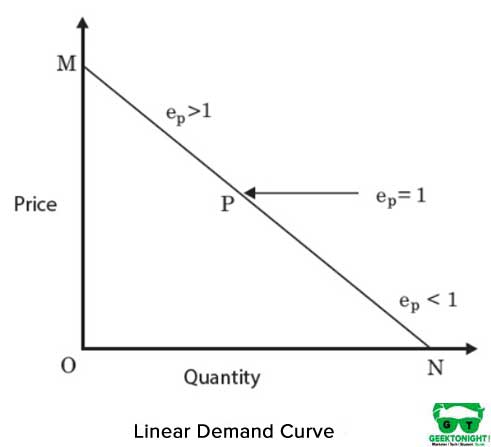
Assume that Figure is drawn to scale if MP is greater than NP
i.e. MP = 10 cms and NP = 8 cms. Calculate the point elasticity at
the point P.
Solution: In Figure 5.9, MN is the demand curve. The elasticity at
the point P can be measured as:
ep = L / U
Here L= NP = 8 cms,
U= MP = 10 cms,
Substituting the values in the formula
ep = 8 / 10
ep = 0.8
Thus, e is 0.8 which is less than one (ep < 1).
Non Linear Demand Curve
In Non Linear Demand Curve, a tangent is drawn that touches point P (price elasticity) at the demand curve. By drawing the tangent, the curve is separated into two parts, namely the upper segment and the lower segment. Let us understand the calculation of price elasticity on a non-linear demand curve.
Non Linear Demand Curve Example
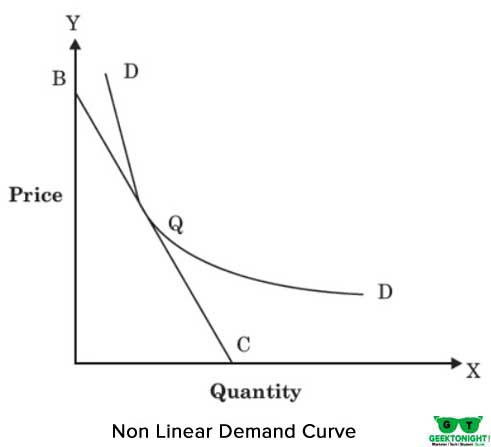
Consider the curve in Figure:
In Figure, DD is a demand curve, and tangent BC meets DD at the point Q dividing into two parts AQ and QB. Assume, QC = 15 and QB = 10.
As per the formula,
ep = L / U
ep = QC/BQ
Substituting the values in the formula we get,
ep = 15/10 = 1.5
Here, e is 1.5, thus greater than one (ep > 1).
Arc elasticity method
Arc elasticity method is used to calculate the elasticity of demand at the midpoint of an arc on the demand curve. In this method, the average of prices and quantities are calculated for finding elasticity.
It is assumed that the elasticity would be same over a range of values of variables considered.
The formula of the arc elasticity method is:
ep= [(ΔQ/ ΔP) X (P+ P1 / Q+Q1)]
Where,
ΔQ is change in quantity (Q1– Q)
ΔP is change in price (P1 – P)
Q is original quantity demanded
Q1 is new quantity demanded
P is original price
P1 is the new price
Arc elasticity method Example
Assume that at the price of ₹50, the demand for the product is 200 units. If the price of the product increases to ₹80, the demand decreases to 150 units. Calculate the price elasticity.
Solution: Given that
P = ₹50
P1 = ₹80
Q = 200
Q1 = 150
ep= [(ΔQ/ ΔP) X (P+ P1 / Q+Q1)]
ep= [(80-50/ 150-200) X (80 + 50 / 200+150)]
Substituting the values in the formula, we get:
ep = (30/-50) X (130/350) = 0.6
As price and demand are inversely related and move in opposing directions. Therefore, the negative sign is ignored. Thus, the price elasticity
of demand is less than one (ep<1).
Factors Affecting Price Elasticity of Demand
Some of the important factors affecting price elasticity of demand are mentioned below:
- Relative need for the product
- Availability of substitute goods
- Impact of income
- Time under consideration
- Perishability of the product
- Addiction
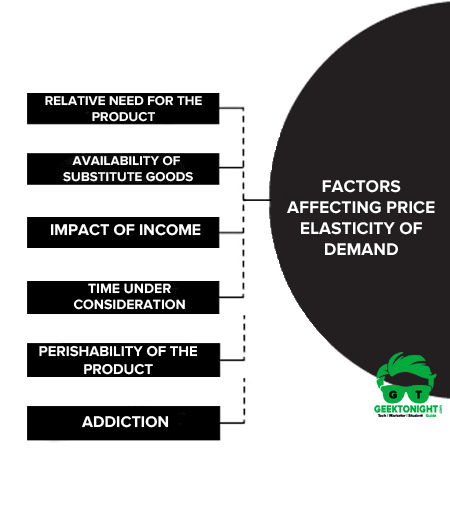
Also Read: Elasticity of Supply
Importance of Price Elasticity of Demand
The concept of price elasticity of demand plays a vital role in the functioning economies by having a significant contribution in the field of industry, trade, and commerce. The major importance of price elasticity of demand are mentioned below:
- Price determination under Monopoly
- Price discrimination
- Formulation of taxation policies
- International trade
- Formulation of agricultural policies
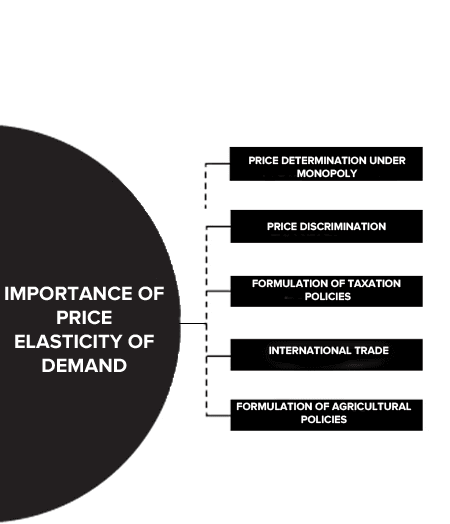
Also Read: Consumer Demand
Business Economics Tutorial
(Click on Topic to Read)
Go On, Share article with Friends
Did we miss something in Business Economics Tutorial? Come on! Tell us what you think about our article on Price Elasticity of Demand | Business Economics in the comments section.
Business Economics Tutorial
(Click on Topic to Read)











